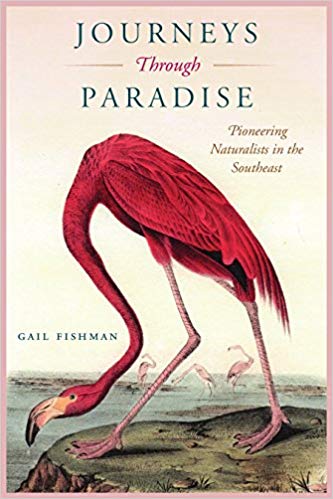"This book is for those inhabited by the same desires that drove the early naturalists afield, who yearn to know wilder territory. We read it voraciously, as if in the understanding of how they loved we might also begin to do so, as if in the reliving of their lives we might recapture some vanishing part of the human psyche that must know wilderness."-- Janisse Ray, author of Ecology of a Cracker Childhood
"Like the naturalists she profiles, Gail Fishman takes us on an odyssey through a time when the extraordinary diversity of the southeastern United States was first being explored and described. . . . Entertaining."-- Steve Gatewood, executive director, Society for Ecological Restoration, Tucson
"Fishman modernizes the men and their explorations by retracing the terrain that they explored, wrote about, drew and painted. The result is an intriguing and appealing lesson in biographical and scientific history and a literary reading experience that will appeal to a wide audience."-- William W. Rogers, professor of history emeritus, Florida State University
Following the original steps of pioneering naturalists, Gail Fishman profiles thirteen men who explored North America’s southeastern wilderness between 1715 and the 1940s, including John James Audubon, Mark Catesby, John and William Bartram, John Muir, and Alvan Wentworth Chapman. The book is also Fishman’s personal travelogue as she experiences the landscape through their eyes and describes the changes that have occurred along the region’s trails and streams.
Traveling by horseback, boat, and foot, these naturalists--dedicated to their task and blessed with passion and insatiable curiosity--explored gentle mountains, regal forests, and shadowy swamps. Their interests ran deeper than merely cataloging plants and animals. They identified the continent’s foundations and the habits and histories of the flora and fauna of the landscape. Fishman tells us who they were and what compelled them to pursue their work. She evaluates what they accomplished and measures their importance, also pointing out their strengths and failings. And she paints an engaging picture of what America was like at the time.
Fishman combines natural history and American history into a series of portraits that recapture the American Southeast as it was seen by those who first tramped through the wilderness and whose voices from the beginning urged the preservation of wild places.
Gail Fishman, a freelance writer who lives in Tallahassee, has worked for the Florida Defenders of the Environment, The Nature Conservancy, and the National Audubon Society. She is a volunteer for the St. Marks National Wildlife Refuge and helped form the St. Marks Refuge Association.
"این کتاب برای کسانی است که با همان امیال زندگی می کنند که طبیعت گرایان اولیه را به دور انداخته است و مشتاق دانستن قلمروهای وحشی هستند. ما آن را با حرص و ولع می خوانیم، گویی برای درک اینکه چگونه آنها دوست داشتند، ما نیز ممکن است شروع به انجام این کار کنیم، گویی در تجدید زندگی آنها ممکن است بخشی ناپدید شده از روان انسان را که باید بیابان را بشناسد، دوباره به دست آوریم."-- جانیس ری، نویسنده اکولوژی کودکی ترقه ای
"گیل فیشمن مانند طبیعت گراهایی که مشخصاتش را معرفی می کند، ما را به ادیسه ای در زمانی می برد که تنوع خارق العاده جنوب شرقی ایالات متحده برای اولین بار کشف و توصیف شد... سرگرم کننده." - استیو گیت وود، مدیر اجرایی انجمن اکولوژیک مرمت، توسان
"فیشمن انسان ها و اکتشافات آنها را با ردیابی مجدد زمین هایی که کاوش کرده اند، نوشته اند، ترسیم کرده اند و نقاشی کرده اند، مدرن می کند. نتیجه یک درس جذاب و جذاب در تاریخ بیوگرافی و علمی و یک تجربه خواندن ادبی است که برای طیف گسترده ای جذاب خواهد بود. مخاطب."-- ویلیام دبلیو راجرز، استاد بازنشسته تاریخ، دانشگاه ایالتی فلوریدا
با پیروی از مراحل اولیه طبیعتشناسان پیشگام، گیل فیشمن سیزده مردی را معرفی میکند که بین سالهای 1715 و 1940 بیابان جنوب شرقی آمریکای شمالی را کاوش کردهاند، از جمله جان جیمز اودوبون، مارک کتسبی، جان و ویلیام بارترام، جان مویر، و الوان ونتورث چپمن. این کتاب همچنین سفرنامه شخصی فیشمن است زیرا او منظره را از طریق چشمان آنها تجربه می کند و تغییراتی را که در مسیرها و نهرهای منطقه رخ داده است، توصیف می کند.
این طبیعتگرایان که با اسب، قایق، و پیاده سفر میکردند - وقف کارشان و با اشتیاق و کنجکاوی سیری ناپذیر - کوههای ملایم، جنگلهای سلطنتی، و باتلاقهای سایهدار را کاوش کردند. علایق آنها عمیق تر از فهرست نویسی صرف گیاهان و حیوانات بود. آنها پایه های قاره و عادات و تاریخچه گیاهان و جانوران چشم انداز را شناسایی کردند. فیشمن به ما می گوید که آنها چه کسانی بودند و چه چیزی آنها را وادار کرد که کار خود را دنبال کنند. او آنچه را که آنها به دست آورده اند ارزیابی می کند و اهمیت آنها را می سنجد و همچنین به نقاط قوت و ضعف آنها اشاره می کند. و او تصویری جذاب از وضعیت آمریکا در آن زمان ترسیم می کند.
فیشمن تاریخ طبیعی و تاریخ آمریکا را در مجموعهای از پرترهها ترکیب میکند که جنوب شرق آمریکا را همانطور که توسط کسانی دیده میشد که برای اولین بار از بیابان عبور کردند و صدایشان از ابتدا بر حفظ مکانهای وحشی تاکید داشت، دوباره به تصویر میکشد.
گیل فیشمن، نویسنده ای آزاد که در تالاهاسی زندگی می کند، برای مدافعان محیط زیست فلوریدا، حفاظت از طبیعت، و انجمن ملی آدوبون کار کرده است. او داوطلب پناهگاه ملی حیات وحش سنت مارکس است و به تشکیل انجمن پناهگاه سنت مارکس کمک کرد.










